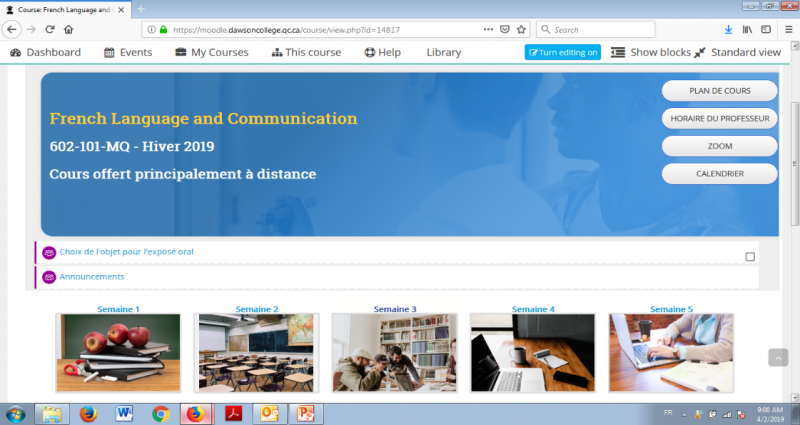The E-learning Fellows group met regularly during the winter 2019 semester to reflect on online pedagogy and explore tools to develop and implement online activities. Although we started only a few months ago, we would like to share some of our reflections and experiences, as well as clarify some aspects of online teaching at Dawson.
Definitions
What do we mean by an online course? While a variety of definitions coexist in different education systems, here are a few basic ones that we use at Dawson.
An online lesson is one that is conducted entirely online and can take one of two forms: synchronous or asynchronous.
Synchronous lessons occur in real time, on a web conferencing platform, during the scheduled course time.
With asynchronous lessons, videos and other learning materials are posted online and students can complete them whenever they choose, within a specified time frame. A good asynchronous lesson includes both online activities and interaction requirements, to ensure that students fulfill course competencies individually or in groups.
Giving an online course does not mean that the students are not communicating with each other. Nor does it mean that the teacher is not there to explain, help, evaluate, answer and guide. Whether a lesson is synchronous or asynchronous, as a matter of best practice the teacher should be available to the students, either physically or virtually, during the assigned class time.
Giving an online course does not mean that the students are not communicating with each other. Nor does it mean that the teacher is not there to explain, help, evaluate, answer and guide.
Over the last decade, most of Dawson’s online courses have been blended courses (partially online). In a blended course, some classes are held in person, while others are given online, with the percentage varying from teacher to teacher. Major evaluations are always given face-to-face.

Why e-learning?
Before diving into the pros and cons of e-learning, it’s useful to consider the changing characteristics of post-secondary students, who are more diverse than ever. Generation Z, born after 1997 and also known as “digitarians,” are the first “always-on” generation. Most are immersed in a variety of media platforms and are quick to use social media, Google and YouTube for personalized, in-the-moment learning. However, we need to be mindful that students’ strengths with social media platforms do not necessarily carry over to educational technology, and teacher support is essential to accommodate varying skill levels, as well as a diversity of learning styles.
Recent years have also seen a rise in learners with special needs, with around 11-17% of students having a self-reported disability (Fichten, 2016). Of these, two-thirds are not registered for accommodations or services. The most common disabilities among students are ADHD, anxiety and other mental health conditions, and these students may not be in an optimal environment for learning when they are in the physical classroom. Having access to their learning materials online can help them a great deal.
One other important change is that today’s students are increasingly working while studying. About half of all Canadian post-secondary students hold down at least one job, and they average 16 hours of work per week (Marshall, 2010). These students can greatly benefit from more autonomous learning opportunities, which allow them to balance work and studies.
Advantages of e-learning for students and teachers
1. Flexibility and autonomy
One of the most notable advantages of online classes for students is flexibility, in terms of time and location. Although synchronous lessons are time-bound, they nonetheless offer flexibility with regard to location. Students who live far from campus are able to participate fully in a lesson without having to be physically present.
With asynchronous lessons, because the activity is prepared and available for an extended period of time, students have the option to view the lecture or supporting material outside of the fixed class time. This can be a big advantage for students who work better at different times during the day or simply want the convenience of consulting the material when it suits them.
Asynchronous online lessons allow students to move at their own pace. In a regular classroom, students who are having trouble following the material may find it hard to speak up, and teachers may find it frustrating to slow down. An online lesson allows these students to revisit ideas they don’t understand as many times as they need, which can be particularly helpful when it comes to preparing for major assignments or examinations.
In winter 2019, one French student reported. “I’m borderline line ADHD and also have reading difficulties so being able to do work on my own time and at my own pace was something I have never experienced before.”
By giving students the autonomy to learn in their own time and at their own pace, a teacher can effectively increase motivation. A well-crafted online lesson empowers students to be active collaborators in their own learning.
2. Accommodating different needs and abilities
Another benefit of asynchronous lessons is that they are an accommodating format that adheres to the principles of Universal Design for Learning (UDL), whereby students can view and review lessons in a way that optimizes their learning experience. Many students report feeling less intimidated and more comfortable communicating through an electronic medium, as compared to participating in class. The online platform can level the playing field between outspoken students and more introverted ones, because all students have an equal opportunity to participate, ask questions and interact with their peers and teacher, without the added pressure of in-class, face-to-face interactions.
The privacy of an online platform gives students a sense of amnesty from their mistakes. In their one-to-one interactions with a teacher online, students report feeling more comfortable and “less afraid of making mistakes”. Needless to say, this can be a big advantage for students suffering from anxiety.

Example of an e-learning platform
3. Supporting of deeper learning
From a pedagogical standpoint, asynchronous lessons can also be delivered as part of a flipped classroom model.[1] A well-designed, asynchronous online lesson can be a very effective means to convey basic theories, concepts and terminology. Students can cover these basics in their own time, and show up more prepared for the following face-to-face class.
When used this way, online teaching offers instructors the chance to dedicate more time in class to deeper analysis and evaluation, and achieve higher level learning.
4. More meaningful interactions
At the heart of online pedagogy is one of its most noteworthy advantages: the close interactions and feedback that can be exchanged between students and teacher. In the same way the instructor can send feedback to students, students can also receive feedback directly from their peers, or learn from analyzing online interactions. For example, forum discussions are rich with information and can help build, and also reveal, students’ level of understanding regarding a particular subject. Teachers can quickly gain insight as to which topics are misunderstood or need to be elaborated on through forums, discussion boards, polls and other tools. They can then tailor the pace and content of lessons to address these points, using the tools available to them through the learning platform. In this way, teachers can get to know their students and their groups more deeply and, as a result, improve the teaching and learning experience.
Challenges of e-learning for students and teachers
Contrary to what one might think, the biggest difficulties students experience with online learning has nothing to do with technology. According to feedback collected during or after various blended courses, Dawson students identify the following main challenges; time management, staying focused on the task and properly scheduling their online learning. Teachers need to be aware that students often struggle in these ways, and find ways to address these obstacles.
Online teaching, despite the many advantages if offers to teachers, also comes with its own set of challenges. One of the biggest obstacles teachers face is the considerable time commitment required to develop new materials. A teacher who thinks that moving part of his or her class online will “save time” is sorely mistaken!
Developing good materials requires sustained and thoughtful deliberation about which lessons are best taught online, and which are best suited to achieve course objectives. Developing an online lesson often requires the teacher to redesign not only individual classes, but also the course as a whole to incorporate the new approach. It’s true that once an asynchronous class is developed, it can be reused in future years (just like a lesson plan for an in-person class). However, as with in-person classes, teachers often modify and improve their offerings year after year.
In both synchronous and asynchronous lessons, time management is a major issue. This stems from the temptation many teachers have to include more material in online lessons than they would in an in-person setting. To avoid overburdening students, the teacher must ensure that a lesson can be reasonably completed in the same amount of time that an in-person class would require. It’s also important to note that, during synchronous lessons, teachers must respond to technical glitches, which can slow things down considerably.
While many students report increased motivation for learning online, some students might not react so positively to the approach. The risk here is that, since the teacher does not meet as often with the class in person, disengaged students risk falling far behind before the instructor notices and can intervene. Consequently, teachers must keep their fingers on the “pulse” of the class, and ensure that students are keeping up and putting in the necessary amount of work.
Here are a few recommendations we can offer to help navigate these challenges:
- Establish the spirit of the class community early in the semester. We found it was useful to have at least a couple of classes together IRL (In Real Life), before we moved to an online environment.
- Explain the pedagogy, roles and expectations clearly to students to avoid any misconceptions about your e-learning class. This should be reiterated regularly throughout the semester.
- Offer a range of learning options and deliver content in different ways (text-based, audio/video, links to additional content, etc.). This helps support your students’ different learning styles. Also, make documents and learning materials accessible in editable formats.
- Be aware of class dynamics. Check in frequently and get to know your students. Make sure they can contact you, both online and in-person, during office hours.
At a broader level, teachers who wish to include on-line components in their courses must address misconceptions about what e-learning entails. It is not about finding an easier way to meet one’s teaching responsibilities, nor is it about making the teacher in the classroom redundant. It is about harnessing good pedagogy with technology to provide students with different types of learning activities so that they can make the best of their education at Dawson.
Developing an online course takes time, effort, and collaboration. We encourage you to try it step by step, one lesson at a time.
If you have questions about online teaching at Dawson, please contact one of us. Rafael Scapin in Information Systems and Technology (IST) and Einat Idan in the Office of Academic Development (OAD) can also give you advice or recommendations.
References
Bates, Tony. (2015). Teaching in a digital age: Guidelines for designing teaching and learning. Retrieved from https://opentextbc.ca/teachinginadigitalage/.
Fichten, C. S., Heiman, T., Havel, A., Jorgensen, M., Budd, J., & King, L. (2016). Sustainability of disability-related services in Canada – Israel: Will the real universal design please stand up? Exceptionality Education International, 26(1), 19-35. Retrieved from http://adaptech.org/wp-content/uploads/abSustainabilityEEI.pdf.
Marshall, K. (2010). Employment patterns of postsecondary students. Perspectives on Labour and Income. Retrieved from https://www150.statcan.gc.ca/n1/en/pub/75-001-x/2010109/pdf/11341-eng.pdf?st=0jHvmLgO.
Endnotes
[1] Flipped classroom is an approach allowing students to read/view novel material before coming to class. In other words, a flipped classroom approach requires that students explore new information on their own. While the primary goal of this strategy is to move and transfer information outside of the classroom, students are not expected to fully grasp all the content (Lasry et al, 2014). Rather, a portion of a subsequent in-class session is often dedicated to addressing student questions/ misconceptions. Ultimately, shifting the students’ initial contact with the material out of the classroom allows for additional class time to be dedicated to group problem solving and active-learning activities that engage students on a deeper level.




